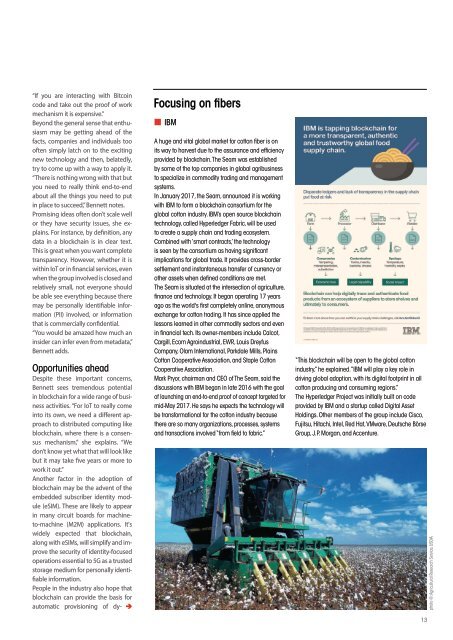Smart Industry 1/2017
Smart Industry 1/2017 - The IoT Business Magazine - powered by Avnet Silica
Smart Industry 1/2017 - The IoT Business Magazine - powered by Avnet Silica
Create successful ePaper yourself
Turn your PDF publications into a flip-book with our unique Google optimized e-Paper software.
“If you are interacting with Bitcoin<br />
code and take out the proof of work<br />
mechanism it is expensive.”<br />
Beyond the general sense that enthusiasm<br />
may be getting ahead of the<br />
facts, companies and individuals too<br />
often simply latch on to the exciting<br />
new technology and then, belatedly,<br />
try to come up with a way to apply it.<br />
“There is nothing wrong with that but<br />
you need to really think end-to-end<br />
about all the things you need to put<br />
in place to succeed,” Bennett notes.<br />
Promising ideas often don’t scale well<br />
or they have security issues, she explains.<br />
For instance, by definition, any<br />
data in a blockchain is in clear text.<br />
This is great when you want complete<br />
transparency. However, whether it is<br />
within IoT or in financial services, even<br />
when the group involved is closed and<br />
relatively small, not everyone should<br />
be able see everything because there<br />
may be personally identifiable information<br />
(PII) involved, or information<br />
that is commercially confidential.<br />
“You would be amazed how much an<br />
insider can infer even from metadata,”<br />
Bennett adds.<br />
Opportunities ahead<br />
Despite these important concerns,<br />
Bennett sees tremendous potential<br />
in blockchain for a wide range of business<br />
activities. “For IoT to really come<br />
into its own, we need a different approach<br />
to distributed computing like<br />
blockchain, where there is a consensus<br />
mechanism,” she explains. “We<br />
don’t know yet what that will look like<br />
but it may take five years or more to<br />
work it out.”<br />
Another factor in the adoption of<br />
blockchain may be the advent of the<br />
embedded subscriber identity module<br />
(eSIM). These are likely to appear<br />
in many circuit boards for machineto-machine<br />
(M2M) app lications. It's<br />
widely expected that blockchain,<br />
along with eSIMs, will simplify and improve<br />
the security of identity-focused<br />
operations essential to 5G as a trusted<br />
storage medium for personally identifiable<br />
information.<br />
People in the industry also hope that<br />
blockchain can provide the basis for<br />
automatic provisioning of dy-<br />
Focusing on fibers<br />
■ IBM<br />
A huge and vital global market for cotton fiber is on<br />
its way to harvest due to the assurance and efficiency<br />
provided by blockchain. The Seam was established<br />
by some of the top companies in global agribusiness<br />
to specialize in commodity trading and management<br />
systems.<br />
In January <strong>2017</strong>, the Seam, announced it is working<br />
with IBM to form a blockchain consortium for the<br />
global cotton industry. IBM’s open source blockchain<br />
technology, called Hyperledger Fabric, will be used<br />
to create a supply chain and trading ecosystem.<br />
Combined with ‘smart contracts,’ the technology<br />
is seen by the consortium as having significant<br />
implications for global trade. It provides cross-border<br />
settlement and instantaneous transfer of currency or<br />
other assets when defined conditions are met.<br />
The Seam is situated at the intersection of agriculture,<br />
finance and technology. It began operating 17 years<br />
ago as the world's first completely online, anonymous<br />
exchange for cotton trading. It has since applied the<br />
lessons learned in other commodity sectors and even<br />
in financial tech. Its owner-members include Calcot,<br />
Cargill, Ecom Agroindustrial, EWR, Louis Dreyfus<br />
Company, Olam International, Parkdale Mills, Plains<br />
Cotton Cooperative Association, and Staple Cotton<br />
Cooperative Association.<br />
Mark Pryor, chairman and CEO of The Seam, said the<br />
discussions with IBM began in late 2016 with the goal<br />
of launching an end-to-end proof of concept targeted for<br />
mid-May <strong>2017</strong>. He says he expects the technology will<br />
be transformational for the cotton industry because<br />
there are so many organizations, processes, systems<br />
and transactions involved “from field to fabric.”<br />
“This blockchain will be open to the global cotton<br />
industry,” he explained. “IBM will play a key role in<br />
driving global adoption, with its digital footprint in all<br />
cotton producing and consuming regions.”<br />
The Hyperledger Project was initially built on code<br />
provided by IBM and a startup called Digital Asset<br />
Holdings. Other members of the group include Cisco,<br />
Fujitsu, Hitachi, Intel, Red Hat, VMware, Deutsche Börse<br />
Group, J.P. Morgan, and Accenture.<br />
13<br />
photo ©: Agricultural Research Service, USDA

















